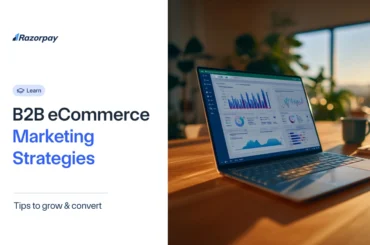Customers are flooded with choices, hundreds of sellers, thousands of products, and an overwhelming variety of prices and features. This is where the aggregator model in e-commerce steps in as a game-changer, simplifying the shopping experience for consumers and opening up new opportunities for businesses. Instead of owning inventory, they collect and organise information, like prices, features, and reviews, so you can easily compare your options side by side.
According to a 2024 Statista survey, over 44% of Indian online shoppers are now using such platforms; aggregators like Amazon, Flipkart, and Zomato have made it easier than ever to find the best deals and choices in one place.
Table of Contents
What is an Aggregator in eCommerce?
An aggregator in eCommerce is a platform that brings together service providers or sellers under one digital roof. Instead of offering its own product or service, an aggregator connects users with third-party providers and ensures a consistent customer experience.
Think of it like a connector—it doesn’t own the food, hotel, or cab, but it helps you find and book them easily.
Example:
- Zomato doesn’t cook food, but it helps you order from restaurants.
- OYO doesn’t own hotels, but it lists and manages them under its platform.
What is the Value for Each Party?
Aggregators create value for all involved parties:
For Customers:
- One-stop access to multiple options
- Consistent user interface and customer service
- Better deals, discounts, and faster comparison
For Service Providers/Sellers:
- Broader reach without investing in their own platform
- Branding and visibility via the aggregator’s reputation
- Payment processing and customer support are handled by the aggregator
For the Aggregator:
- Revenue from commissions, ads, subscriptions, or convenience fees
- Data insights and customer trends for future growth
Popular Industries for Aggregators
Aggregators have gained popularity across several industries. Let’s look at the most common ones:
Food Delivery Aggregators
These platforms tie up with local restaurants and deliver food to customers’ doorsteps.
Examples in India: Zomato, Swiggy
Key Features: Real-time tracking, multiple payment options, reviews & ratings
Value: Makes dining at home easy and quick, especially during busy workdays.
Hotel Aggregators
These allow you to browse, compare, and book hotels without visiting multiple hotel websites.
Examples: OYO, MakeMyTrip, Agoda
Value for Travellers: Transparent pricing, photos, reviews, flexible cancellation
Value for Hotels: Better occupancy, digital visibility, and easier inventory management
Shipping Aggregators for eCom Stores
eCommerce sellers can integrate with shipping aggregators to manage deliveries across multiple couriers.
Examples: Shiprocket, Pickrr, NimbusPost
Benefits: Automated tracking, better rates, bulk shipment management
Ideal For: D2C brands, small businesses selling on Amazon, Shopify, etc.
Taxi Booking Aggregators
These apps help users book cabs or autos from different drivers in one app.
Examples: Ola, Uber, Rapido
Perks: Live tracking, price estimates, driver reviews
For Drivers: Flexible income, tech-enabled ride matching, less idle time
Aggregator vs. Marketplace: What Unites Them?
Though often confused, both models share some similarities:
- Platform-Based: Both connect buyers with multiple sellers or service providers.
- Tech-Driven: Use apps or websites for user interaction and backend processes.
- Revenue Models: Earn through commissions, convenience fees, or subscriptions.
- Support System: Offer dispute resolution, customer service, and refunds on behalf of partners.
Marketplace Model vs Aggregator Model: What Sets Them Apart?
Feature |
Marketplace Model |
Aggregator Model |
| Ownership of Listings | Sellers list independently | Aggregator manages listings |
| Brand Uniformity | Each seller has its own branding | Unified branding (e.g., OYO hotels) |
| Pricing Control | Sellers decide prices | An aggregator often standardises prices |
| Service Quality | Varies by seller | Maintained by an aggregator |
| Examples | Amazon, Flipkart | Zomato, Ola, OYO |
In short, aggregators focus on consistency and standardisation, while marketplaces are more of a digital bazaar.
The Cost to Develop an eCommerce Aggregator
Creating an aggregator platform in India can vary depending on features, complexity, and the development team. Here’s a breakdown:
Component |
Estimated Cost (₹) |
| Basic UI/UX Design | ₹50,000 – ₹1,00,000 |
| Frontend & Backend Development | ₹3,00,000 – ₹7,00,000 |
| Mobile App (Android + iOS) | ₹4,00,000 – ₹8,00,000 |
| Admin Panel & Dashboard | ₹1,00,000 – ₹2,00,000 |
| Payment Gateway Integration | ₹50,000 – ₹1,00,000 |
| Testing & QA | ₹50,000 – ₹1,00,000 |
| Total Development Cost | ₹10,00,000 – ₹20,00,000+ |
Note:
- Costs can be lower with freelancers or small agencies, but quality and support may vary.
- Maintenance, hosting, and marketing are extra and ongoing expenses.
- Complex features like AI-based recommendations or dynamic pricing can push the cost higher.
Market Trends and Consumer Adoption
The global e-commerce landscape is experiencing robust growth, fuelled by rising internet penetration, mobile adoption, and evolving consumer preferences for convenience and variety. By 2025, global e-commerce retail sales are projected to reach approximately ₹631.7 lakh crore, with 85% of consumers worldwide now shopping online. Asia remains the leader in online shopping adoption, with countries like China accounting for over half (52.1%) of global e-commerce sales, followed by the United States at 20.1%.
In India, the shift is equally dramatic. According to market observations and industry analysts, a significant share of Indian shoppers are increasingly turning to aggregator platforms to compare products and prices conveniently, shaping modern shopping habits and driving the next wave of e-commerce adoption.
Key Features of the Aggregator Model
The aggregator business model is characterised by several key features that set it apart from traditional e-commerce models:
- Ease of comparison: Aggregators let customers easily compare offerings from multiple providers.
- Lack of inventory ownership: Unlike traditional retailers, aggregators don’t own or manage inventory, focusing instead on information aggregation.
- Information-centric approach: Their main goal is to provide accurate, comprehensive data for informed decisions.
- Access to a larger audience: As partners, you gain access to a larger customer base without direct sales channels.
1. Target Customers:
The aggregator model caters to a broad range of customers seeking convenience, variety, and the best value for their money. These customers value the ability to compare options and make informed decisions quickly.
2. Industry:
Aggregator models are prevalent in various industries, including e-commerce, travel, real estate, and financial services. They have the potential to disrupt traditional business models by providing a more efficient and customer-centric approach.
3. Role of Partnerships:
Partnerships play a crucial role in the success of an aggregator model. Aggregators rely on strong relationships with suppliers, service providers, and other stakeholders to ensure a comprehensive and up-to-date selection of offerings.
4. Brand Image:
Aggregators often prioritise building a strong brand image associated with trust, reliability, and customer-centricity. This helps them attract and retain customers in a competitive market.
Types of Aggregators
There are several types of aggregators, each focusing on a specific area or industry. Some common examples include:
- Search aggregators- These combine results from multiple search engines for broader information. e.g., Dogpile
- Content aggregators- They gather news or media from various sources into one feed. e.g., Google News
- Shopping aggregators- They let users compare and buy products from different sellers. e.g., Amazon
- Real estate aggregators- They list properties from various agents for easy home search. e.g., Zillow
Conclusion
The aggregator model in e-commerce has revolutionised the way consumers shop online, providing them with a convenient, information-rich, and user-friendly experience. By collecting and presenting data from multiple sources, aggregators enable customers to make informed decisions while saving time and effort. For businesses, partnering with an aggregator can lead to increased visibility, a larger customer base, and improved efficiency. As the e-commerce landscape continues to evolve, the aggregator model is poised to play an increasingly important role in shaping the future of online shopping.
Frequently Asked Questions (FAQs):
1. What industries can benefit from the aggregator model?
Industries like e-commerce, travel, real estate, and financial services benefit, especially where customers need to compare options.
2. How does the aggregator model differ from other e-commerce models?
Aggregator models don’t own inventory; they present offerings from multiple sources for easy comparison, unlike traditional e-commerce, which manages its own stock.
3. What are the challenges of the aggregator model?
The key challenges include ensuring information accuracy, managing multiple partners, adapting to market changes, and maintaining brand trust.
4. What is the role of partnerships in the aggregator model?
Partnerships are essential for the success of an aggregator model. Strong partnerships ensure a wide, updated selection and help aggregators expand reach and enhance customer experience.
Source of References:




